Evolution of Child Friendly Open Space in Cities
VerifiedAdded on 2023/06/14
|11
|4167
|167
AI Summary
This report discusses the importance of child friendly open space in cities for children's physical and emotional development. It focuses on the current scenario of child friendly open space in Dhaka city, Bangladesh and provides information on various parameters and standards for designing child friendly open spaces. The report also highlights the need for green open spaces and the importance of maintaining hygiene and good security for children's wellbeing.
Contribute Materials
Your contribution can guide someone’s learning journey. Share your
documents today.
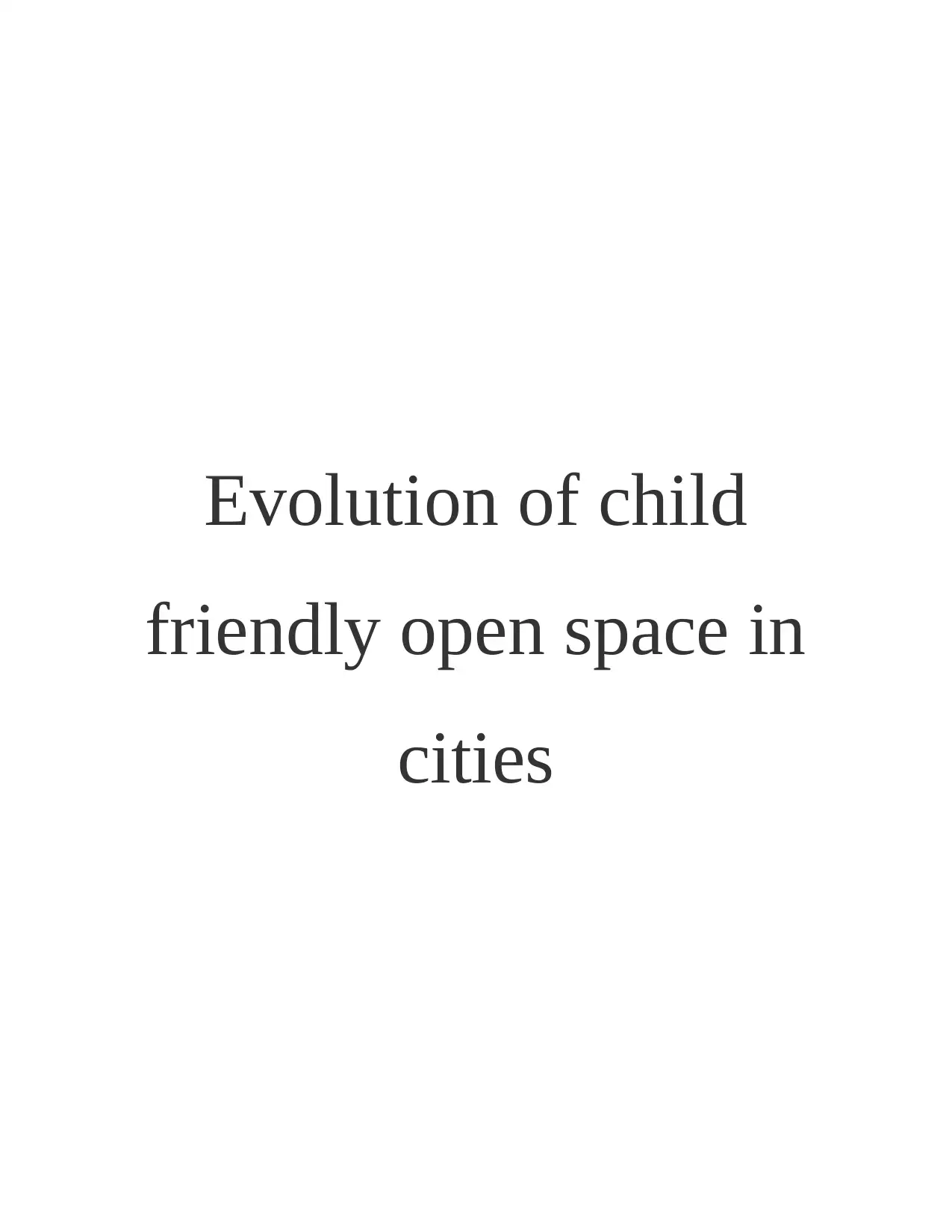
Evolution of child
friendly open space in
cities
friendly open space in
cities
Secure Best Marks with AI Grader
Need help grading? Try our AI Grader for instant feedback on your assignments.

Table of Contents
INTRODUCTION...........................................................................................................................3
MAIN BODY...................................................................................................................................3
CONCLUSION................................................................................................................................9
REFERENCES..............................................................................................................................10
INTRODUCTION...........................................................................................................................3
MAIN BODY...................................................................................................................................3
CONCLUSION................................................................................................................................9
REFERENCES..............................................................................................................................10
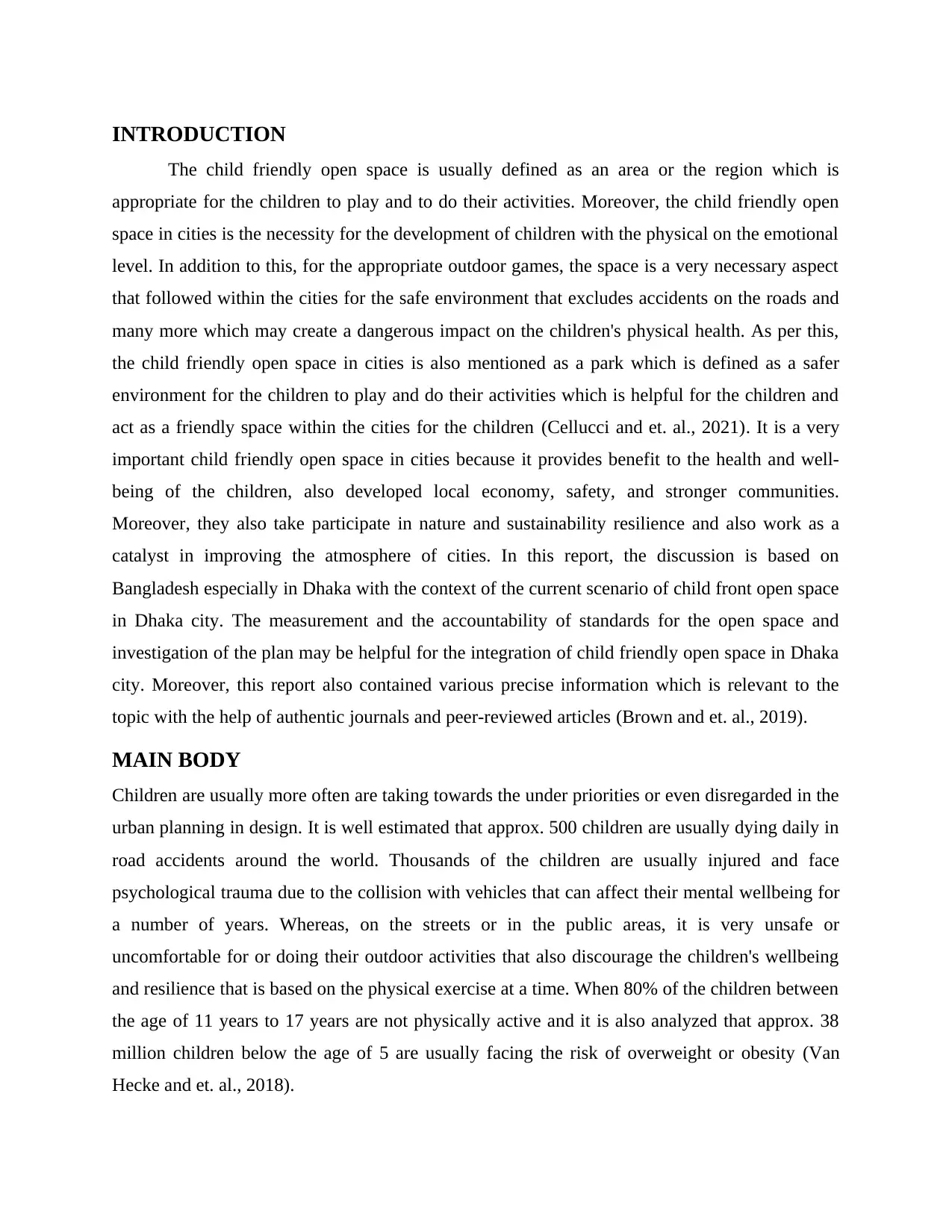
INTRODUCTION
The child friendly open space is usually defined as an area or the region which is
appropriate for the children to play and to do their activities. Moreover, the child friendly open
space in cities is the necessity for the development of children with the physical on the emotional
level. In addition to this, for the appropriate outdoor games, the space is a very necessary aspect
that followed within the cities for the safe environment that excludes accidents on the roads and
many more which may create a dangerous impact on the children's physical health. As per this,
the child friendly open space in cities is also mentioned as a park which is defined as a safer
environment for the children to play and do their activities which is helpful for the children and
act as a friendly space within the cities for the children (Cellucci and et. al., 2021). It is a very
important child friendly open space in cities because it provides benefit to the health and well-
being of the children, also developed local economy, safety, and stronger communities.
Moreover, they also take participate in nature and sustainability resilience and also work as a
catalyst in improving the atmosphere of cities. In this report, the discussion is based on
Bangladesh especially in Dhaka with the context of the current scenario of child front open space
in Dhaka city. The measurement and the accountability of standards for the open space and
investigation of the plan may be helpful for the integration of child friendly open space in Dhaka
city. Moreover, this report also contained various precise information which is relevant to the
topic with the help of authentic journals and peer-reviewed articles (Brown and et. al., 2019).
MAIN BODY
Children are usually more often are taking towards the under priorities or even disregarded in the
urban planning in design. It is well estimated that approx. 500 children are usually dying daily in
road accidents around the world. Thousands of the children are usually injured and face
psychological trauma due to the collision with vehicles that can affect their mental wellbeing for
a number of years. Whereas, on the streets or in the public areas, it is very unsafe or
uncomfortable for or doing their outdoor activities that also discourage the children's wellbeing
and resilience that is based on the physical exercise at a time. When 80% of the children between
the age of 11 years to 17 years are not physically active and it is also analyzed that approx. 38
million children below the age of 5 are usually facing the risk of overweight or obesity (Van
Hecke and et. al., 2018).
The child friendly open space is usually defined as an area or the region which is
appropriate for the children to play and to do their activities. Moreover, the child friendly open
space in cities is the necessity for the development of children with the physical on the emotional
level. In addition to this, for the appropriate outdoor games, the space is a very necessary aspect
that followed within the cities for the safe environment that excludes accidents on the roads and
many more which may create a dangerous impact on the children's physical health. As per this,
the child friendly open space in cities is also mentioned as a park which is defined as a safer
environment for the children to play and do their activities which is helpful for the children and
act as a friendly space within the cities for the children (Cellucci and et. al., 2021). It is a very
important child friendly open space in cities because it provides benefit to the health and well-
being of the children, also developed local economy, safety, and stronger communities.
Moreover, they also take participate in nature and sustainability resilience and also work as a
catalyst in improving the atmosphere of cities. In this report, the discussion is based on
Bangladesh especially in Dhaka with the context of the current scenario of child front open space
in Dhaka city. The measurement and the accountability of standards for the open space and
investigation of the plan may be helpful for the integration of child friendly open space in Dhaka
city. Moreover, this report also contained various precise information which is relevant to the
topic with the help of authentic journals and peer-reviewed articles (Brown and et. al., 2019).
MAIN BODY
Children are usually more often are taking towards the under priorities or even disregarded in the
urban planning in design. It is well estimated that approx. 500 children are usually dying daily in
road accidents around the world. Thousands of the children are usually injured and face
psychological trauma due to the collision with vehicles that can affect their mental wellbeing for
a number of years. Whereas, on the streets or in the public areas, it is very unsafe or
uncomfortable for or doing their outdoor activities that also discourage the children's wellbeing
and resilience that is based on the physical exercise at a time. When 80% of the children between
the age of 11 years to 17 years are not physically active and it is also analyzed that approx. 38
million children below the age of 5 are usually facing the risk of overweight or obesity (Van
Hecke and et. al., 2018).
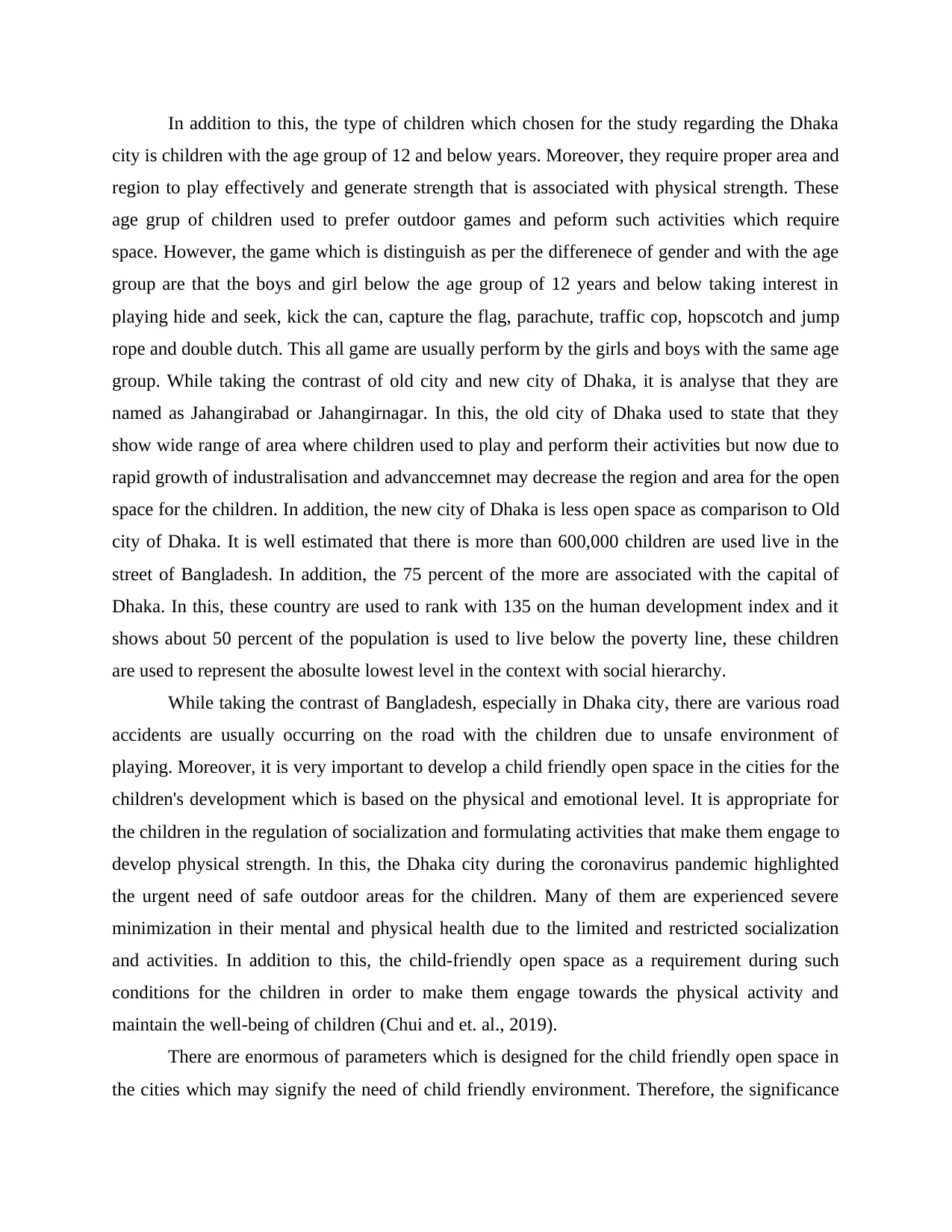
In addition to this, the type of children which chosen for the study regarding the Dhaka
city is children with the age group of 12 and below years. Moreover, they require proper area and
region to play effectively and generate strength that is associated with physical strength. These
age grup of children used to prefer outdoor games and peform such activities which require
space. However, the game which is distinguish as per the differenece of gender and with the age
group are that the boys and girl below the age group of 12 years and below taking interest in
playing hide and seek, kick the can, capture the flag, parachute, traffic cop, hopscotch and jump
rope and double dutch. This all game are usually perform by the girls and boys with the same age
group. While taking the contrast of old city and new city of Dhaka, it is analyse that they are
named as Jahangirabad or Jahangirnagar. In this, the old city of Dhaka used to state that they
show wide range of area where children used to play and perform their activities but now due to
rapid growth of industralisation and advanccemnet may decrease the region and area for the open
space for the children. In addition, the new city of Dhaka is less open space as comparison to Old
city of Dhaka. It is well estimated that there is more than 600,000 children are used live in the
street of Bangladesh. In addition, the 75 percent of the more are associated with the capital of
Dhaka. In this, these country are used to rank with 135 on the human development index and it
shows about 50 percent of the population is used to live below the poverty line, these children
are used to represent the abosulte lowest level in the context with social hierarchy.
While taking the contrast of Bangladesh, especially in Dhaka city, there are various road
accidents are usually occurring on the road with the children due to unsafe environment of
playing. Moreover, it is very important to develop a child friendly open space in the cities for the
children's development which is based on the physical and emotional level. It is appropriate for
the children in the regulation of socialization and formulating activities that make them engage to
develop physical strength. In this, the Dhaka city during the coronavirus pandemic highlighted
the urgent need of safe outdoor areas for the children. Many of them are experienced severe
minimization in their mental and physical health due to the limited and restricted socialization
and activities. In addition to this, the child-friendly open space as a requirement during such
conditions for the children in order to make them engage towards the physical activity and
maintain the well-being of children (Chui and et. al., 2019).
There are enormous of parameters which is designed for the child friendly open space in
the cities which may signify the need of child friendly environment. Therefore, the significance
city is children with the age group of 12 and below years. Moreover, they require proper area and
region to play effectively and generate strength that is associated with physical strength. These
age grup of children used to prefer outdoor games and peform such activities which require
space. However, the game which is distinguish as per the differenece of gender and with the age
group are that the boys and girl below the age group of 12 years and below taking interest in
playing hide and seek, kick the can, capture the flag, parachute, traffic cop, hopscotch and jump
rope and double dutch. This all game are usually perform by the girls and boys with the same age
group. While taking the contrast of old city and new city of Dhaka, it is analyse that they are
named as Jahangirabad or Jahangirnagar. In this, the old city of Dhaka used to state that they
show wide range of area where children used to play and perform their activities but now due to
rapid growth of industralisation and advanccemnet may decrease the region and area for the open
space for the children. In addition, the new city of Dhaka is less open space as comparison to Old
city of Dhaka. It is well estimated that there is more than 600,000 children are used live in the
street of Bangladesh. In addition, the 75 percent of the more are associated with the capital of
Dhaka. In this, these country are used to rank with 135 on the human development index and it
shows about 50 percent of the population is used to live below the poverty line, these children
are used to represent the abosulte lowest level in the context with social hierarchy.
While taking the contrast of Bangladesh, especially in Dhaka city, there are various road
accidents are usually occurring on the road with the children due to unsafe environment of
playing. Moreover, it is very important to develop a child friendly open space in the cities for the
children's development which is based on the physical and emotional level. It is appropriate for
the children in the regulation of socialization and formulating activities that make them engage to
develop physical strength. In this, the Dhaka city during the coronavirus pandemic highlighted
the urgent need of safe outdoor areas for the children. Many of them are experienced severe
minimization in their mental and physical health due to the limited and restricted socialization
and activities. In addition to this, the child-friendly open space as a requirement during such
conditions for the children in order to make them engage towards the physical activity and
maintain the well-being of children (Chui and et. al., 2019).
There are enormous of parameters which is designed for the child friendly open space in
the cities which may signify the need of child friendly environment. Therefore, the significance
Secure Best Marks with AI Grader
Need help grading? Try our AI Grader for instant feedback on your assignments.
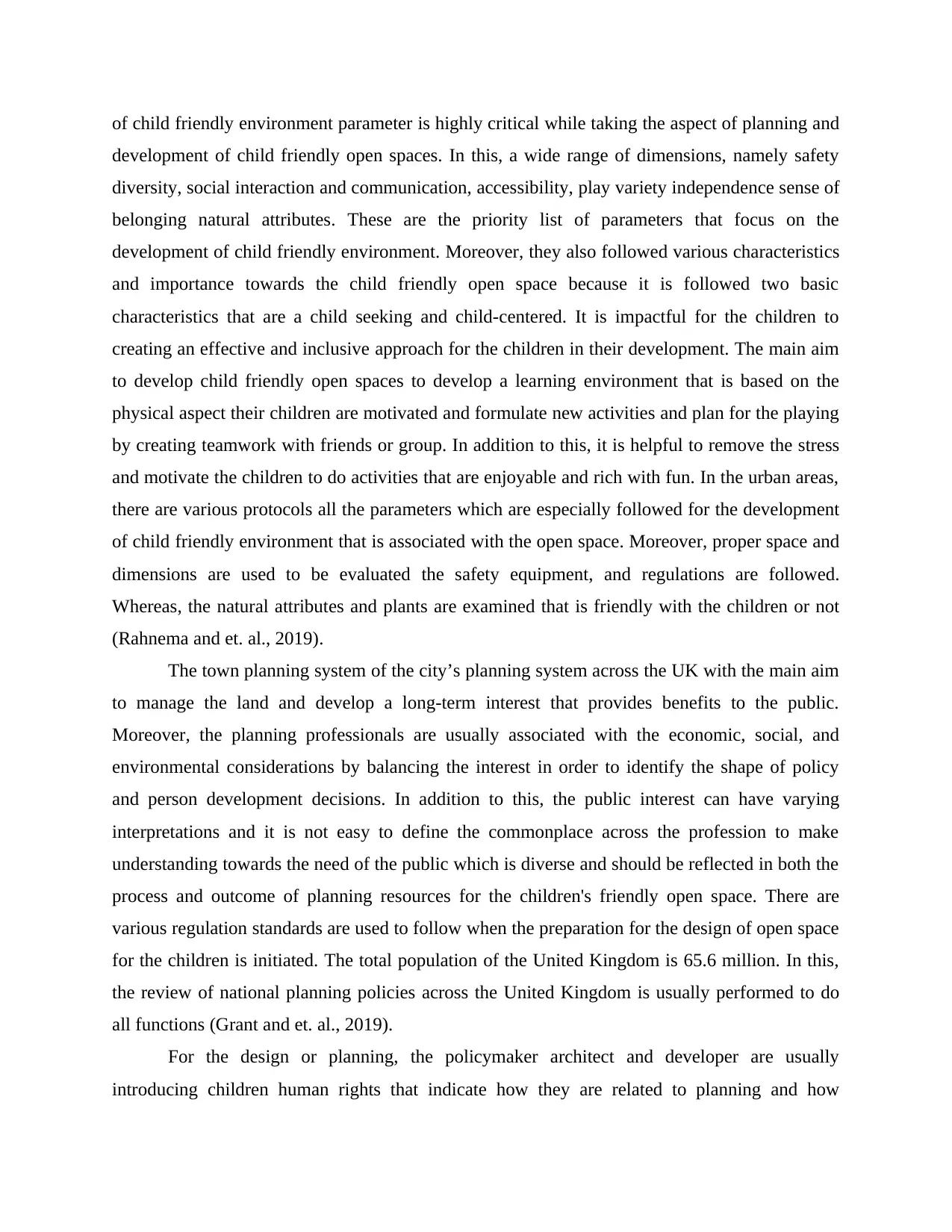
of child friendly environment parameter is highly critical while taking the aspect of planning and
development of child friendly open spaces. In this, a wide range of dimensions, namely safety
diversity, social interaction and communication, accessibility, play variety independence sense of
belonging natural attributes. These are the priority list of parameters that focus on the
development of child friendly environment. Moreover, they also followed various characteristics
and importance towards the child friendly open space because it is followed two basic
characteristics that are a child seeking and child-centered. It is impactful for the children to
creating an effective and inclusive approach for the children in their development. The main aim
to develop child friendly open spaces to develop a learning environment that is based on the
physical aspect their children are motivated and formulate new activities and plan for the playing
by creating teamwork with friends or group. In addition to this, it is helpful to remove the stress
and motivate the children to do activities that are enjoyable and rich with fun. In the urban areas,
there are various protocols all the parameters which are especially followed for the development
of child friendly environment that is associated with the open space. Moreover, proper space and
dimensions are used to be evaluated the safety equipment, and regulations are followed.
Whereas, the natural attributes and plants are examined that is friendly with the children or not
(Rahnema and et. al., 2019).
The town planning system of the city’s planning system across the UK with the main aim
to manage the land and develop a long-term interest that provides benefits to the public.
Moreover, the planning professionals are usually associated with the economic, social, and
environmental considerations by balancing the interest in order to identify the shape of policy
and person development decisions. In addition to this, the public interest can have varying
interpretations and it is not easy to define the commonplace across the profession to make
understanding towards the need of the public which is diverse and should be reflected in both the
process and outcome of planning resources for the children's friendly open space. There are
various regulation standards are used to follow when the preparation for the design of open space
for the children is initiated. The total population of the United Kingdom is 65.6 million. In this,
the review of national planning policies across the United Kingdom is usually performed to do
all functions (Grant and et. al., 2019).
For the design or planning, the policymaker architect and developer are usually
introducing children human rights that indicate how they are related to planning and how
development of child friendly open spaces. In this, a wide range of dimensions, namely safety
diversity, social interaction and communication, accessibility, play variety independence sense of
belonging natural attributes. These are the priority list of parameters that focus on the
development of child friendly environment. Moreover, they also followed various characteristics
and importance towards the child friendly open space because it is followed two basic
characteristics that are a child seeking and child-centered. It is impactful for the children to
creating an effective and inclusive approach for the children in their development. The main aim
to develop child friendly open spaces to develop a learning environment that is based on the
physical aspect their children are motivated and formulate new activities and plan for the playing
by creating teamwork with friends or group. In addition to this, it is helpful to remove the stress
and motivate the children to do activities that are enjoyable and rich with fun. In the urban areas,
there are various protocols all the parameters which are especially followed for the development
of child friendly environment that is associated with the open space. Moreover, proper space and
dimensions are used to be evaluated the safety equipment, and regulations are followed.
Whereas, the natural attributes and plants are examined that is friendly with the children or not
(Rahnema and et. al., 2019).
The town planning system of the city’s planning system across the UK with the main aim
to manage the land and develop a long-term interest that provides benefits to the public.
Moreover, the planning professionals are usually associated with the economic, social, and
environmental considerations by balancing the interest in order to identify the shape of policy
and person development decisions. In addition to this, the public interest can have varying
interpretations and it is not easy to define the commonplace across the profession to make
understanding towards the need of the public which is diverse and should be reflected in both the
process and outcome of planning resources for the children's friendly open space. There are
various regulation standards are used to follow when the preparation for the design of open space
for the children is initiated. The total population of the United Kingdom is 65.6 million. In this,
the review of national planning policies across the United Kingdom is usually performed to do
all functions (Grant and et. al., 2019).
For the design or planning, the policymaker architect and developer are usually
introducing children human rights that indicate how they are related to planning and how
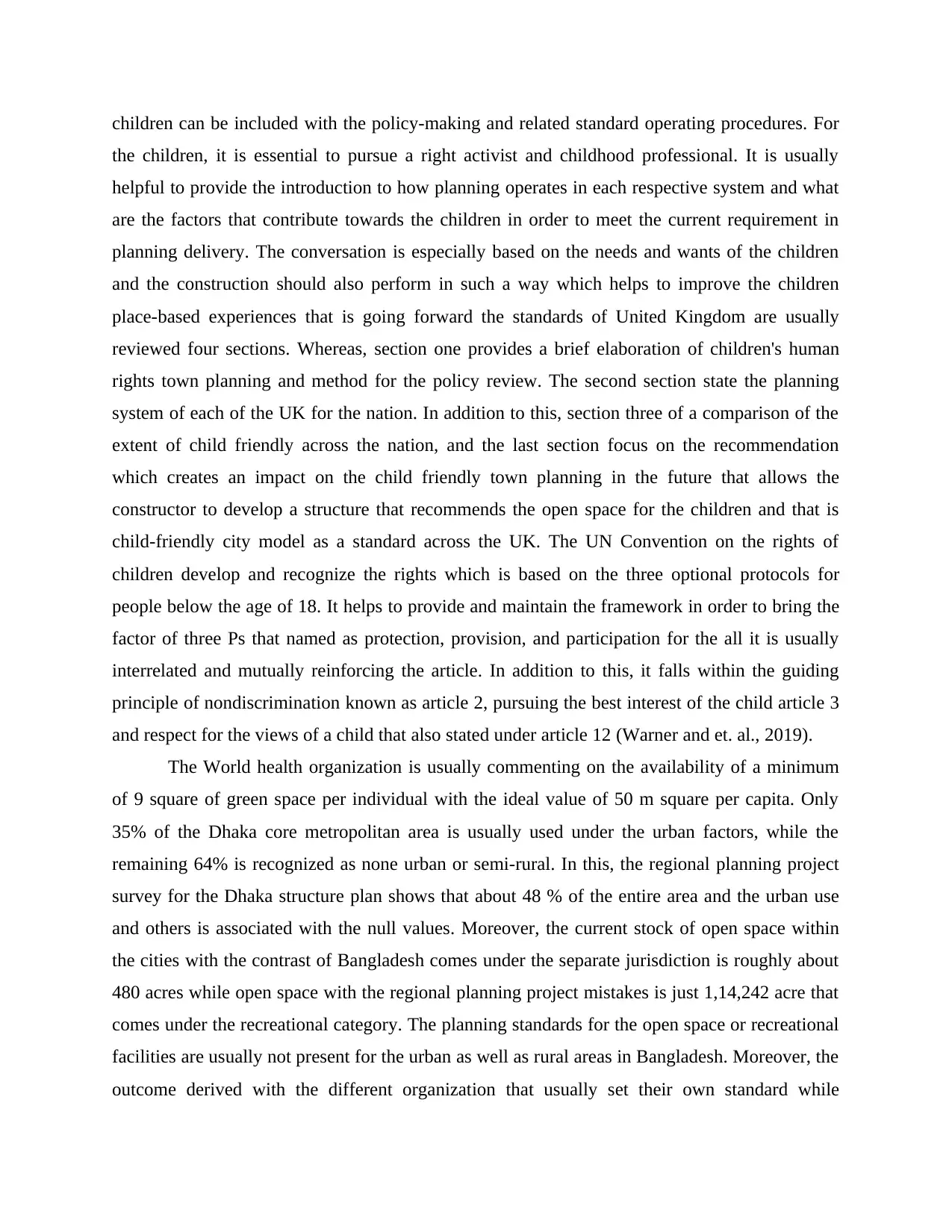
children can be included with the policy-making and related standard operating procedures. For
the children, it is essential to pursue a right activist and childhood professional. It is usually
helpful to provide the introduction to how planning operates in each respective system and what
are the factors that contribute towards the children in order to meet the current requirement in
planning delivery. The conversation is especially based on the needs and wants of the children
and the construction should also perform in such a way which helps to improve the children
place-based experiences that is going forward the standards of United Kingdom are usually
reviewed four sections. Whereas, section one provides a brief elaboration of children's human
rights town planning and method for the policy review. The second section state the planning
system of each of the UK for the nation. In addition to this, section three of a comparison of the
extent of child friendly across the nation, and the last section focus on the recommendation
which creates an impact on the child friendly town planning in the future that allows the
constructor to develop a structure that recommends the open space for the children and that is
child-friendly city model as a standard across the UK. The UN Convention on the rights of
children develop and recognize the rights which is based on the three optional protocols for
people below the age of 18. It helps to provide and maintain the framework in order to bring the
factor of three Ps that named as protection, provision, and participation for the all it is usually
interrelated and mutually reinforcing the article. In addition to this, it falls within the guiding
principle of nondiscrimination known as article 2, pursuing the best interest of the child article 3
and respect for the views of a child that also stated under article 12 (Warner and et. al., 2019).
The World health organization is usually commenting on the availability of a minimum
of 9 square of green space per individual with the ideal value of 50 m square per capita. Only
35% of the Dhaka core metropolitan area is usually used under the urban factors, while the
remaining 64% is recognized as none urban or semi-rural. In this, the regional planning project
survey for the Dhaka structure plan shows that about 48 % of the entire area and the urban use
and others is associated with the null values. Moreover, the current stock of open space within
the cities with the contrast of Bangladesh comes under the separate jurisdiction is roughly about
480 acres while open space with the regional planning project mistakes is just 1,14,242 acre that
comes under the recreational category. The planning standards for the open space or recreational
facilities are usually not present for the urban as well as rural areas in Bangladesh. Moreover, the
outcome derived with the different organization that usually set their own standard while
the children, it is essential to pursue a right activist and childhood professional. It is usually
helpful to provide the introduction to how planning operates in each respective system and what
are the factors that contribute towards the children in order to meet the current requirement in
planning delivery. The conversation is especially based on the needs and wants of the children
and the construction should also perform in such a way which helps to improve the children
place-based experiences that is going forward the standards of United Kingdom are usually
reviewed four sections. Whereas, section one provides a brief elaboration of children's human
rights town planning and method for the policy review. The second section state the planning
system of each of the UK for the nation. In addition to this, section three of a comparison of the
extent of child friendly across the nation, and the last section focus on the recommendation
which creates an impact on the child friendly town planning in the future that allows the
constructor to develop a structure that recommends the open space for the children and that is
child-friendly city model as a standard across the UK. The UN Convention on the rights of
children develop and recognize the rights which is based on the three optional protocols for
people below the age of 18. It helps to provide and maintain the framework in order to bring the
factor of three Ps that named as protection, provision, and participation for the all it is usually
interrelated and mutually reinforcing the article. In addition to this, it falls within the guiding
principle of nondiscrimination known as article 2, pursuing the best interest of the child article 3
and respect for the views of a child that also stated under article 12 (Warner and et. al., 2019).
The World health organization is usually commenting on the availability of a minimum
of 9 square of green space per individual with the ideal value of 50 m square per capita. Only
35% of the Dhaka core metropolitan area is usually used under the urban factors, while the
remaining 64% is recognized as none urban or semi-rural. In this, the regional planning project
survey for the Dhaka structure plan shows that about 48 % of the entire area and the urban use
and others is associated with the null values. Moreover, the current stock of open space within
the cities with the contrast of Bangladesh comes under the separate jurisdiction is roughly about
480 acres while open space with the regional planning project mistakes is just 1,14,242 acre that
comes under the recreational category. The planning standards for the open space or recreational
facilities are usually not present for the urban as well as rural areas in Bangladesh. Moreover, the
outcome derived with the different organization that usually set their own standard while
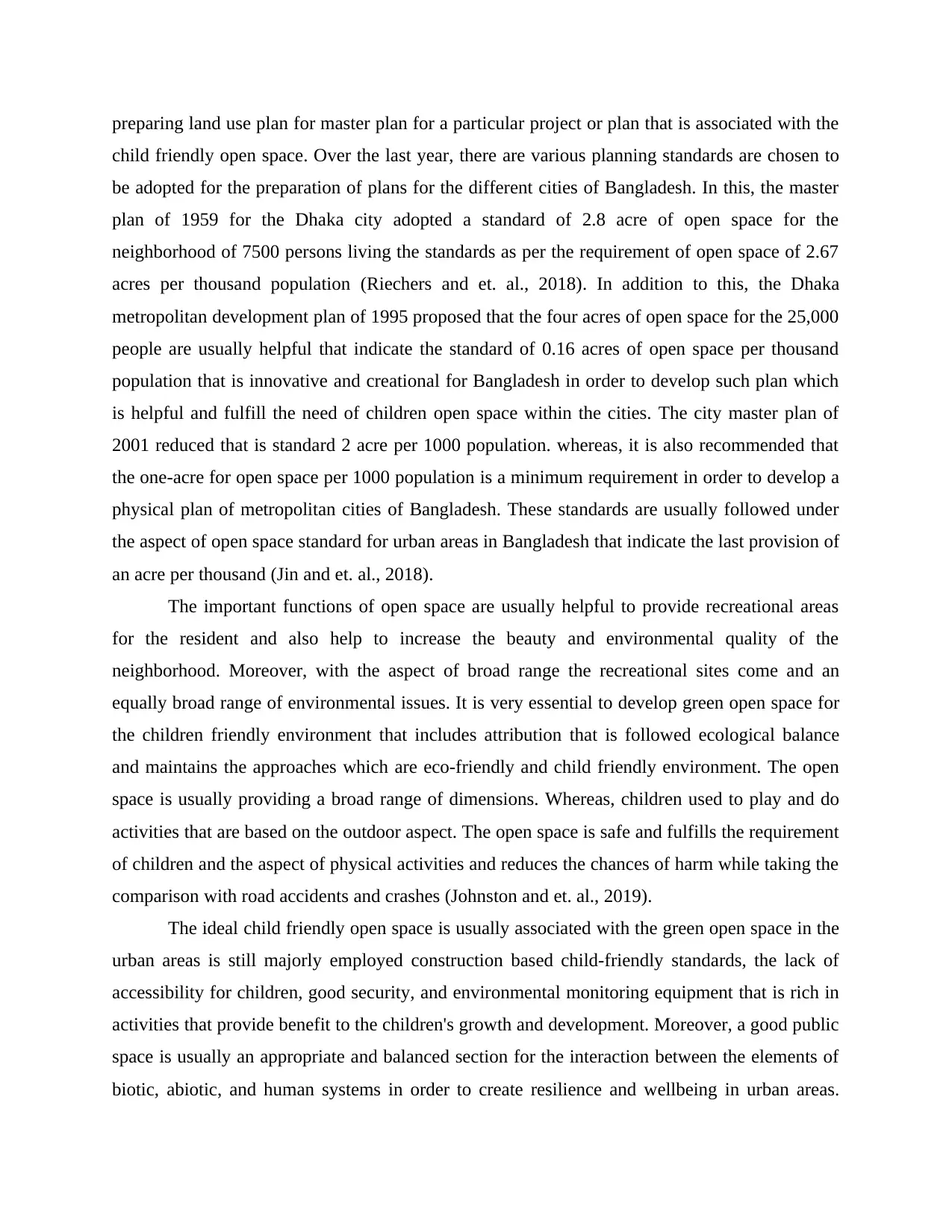
preparing land use plan for master plan for a particular project or plan that is associated with the
child friendly open space. Over the last year, there are various planning standards are chosen to
be adopted for the preparation of plans for the different cities of Bangladesh. In this, the master
plan of 1959 for the Dhaka city adopted a standard of 2.8 acre of open space for the
neighborhood of 7500 persons living the standards as per the requirement of open space of 2.67
acres per thousand population (Riechers and et. al., 2018). In addition to this, the Dhaka
metropolitan development plan of 1995 proposed that the four acres of open space for the 25,000
people are usually helpful that indicate the standard of 0.16 acres of open space per thousand
population that is innovative and creational for Bangladesh in order to develop such plan which
is helpful and fulfill the need of children open space within the cities. The city master plan of
2001 reduced that is standard 2 acre per 1000 population. whereas, it is also recommended that
the one-acre for open space per 1000 population is a minimum requirement in order to develop a
physical plan of metropolitan cities of Bangladesh. These standards are usually followed under
the aspect of open space standard for urban areas in Bangladesh that indicate the last provision of
an acre per thousand (Jin and et. al., 2018).
The important functions of open space are usually helpful to provide recreational areas
for the resident and also help to increase the beauty and environmental quality of the
neighborhood. Moreover, with the aspect of broad range the recreational sites come and an
equally broad range of environmental issues. It is very essential to develop green open space for
the children friendly environment that includes attribution that is followed ecological balance
and maintains the approaches which are eco-friendly and child friendly environment. The open
space is usually providing a broad range of dimensions. Whereas, children used to play and do
activities that are based on the outdoor aspect. The open space is safe and fulfills the requirement
of children and the aspect of physical activities and reduces the chances of harm while taking the
comparison with road accidents and crashes (Johnston and et. al., 2019).
The ideal child friendly open space is usually associated with the green open space in the
urban areas is still majorly employed construction based child-friendly standards, the lack of
accessibility for children, good security, and environmental monitoring equipment that is rich in
activities that provide benefit to the children's growth and development. Moreover, a good public
space is usually an appropriate and balanced section for the interaction between the elements of
biotic, abiotic, and human systems in order to create resilience and wellbeing in urban areas.
child friendly open space. Over the last year, there are various planning standards are chosen to
be adopted for the preparation of plans for the different cities of Bangladesh. In this, the master
plan of 1959 for the Dhaka city adopted a standard of 2.8 acre of open space for the
neighborhood of 7500 persons living the standards as per the requirement of open space of 2.67
acres per thousand population (Riechers and et. al., 2018). In addition to this, the Dhaka
metropolitan development plan of 1995 proposed that the four acres of open space for the 25,000
people are usually helpful that indicate the standard of 0.16 acres of open space per thousand
population that is innovative and creational for Bangladesh in order to develop such plan which
is helpful and fulfill the need of children open space within the cities. The city master plan of
2001 reduced that is standard 2 acre per 1000 population. whereas, it is also recommended that
the one-acre for open space per 1000 population is a minimum requirement in order to develop a
physical plan of metropolitan cities of Bangladesh. These standards are usually followed under
the aspect of open space standard for urban areas in Bangladesh that indicate the last provision of
an acre per thousand (Jin and et. al., 2018).
The important functions of open space are usually helpful to provide recreational areas
for the resident and also help to increase the beauty and environmental quality of the
neighborhood. Moreover, with the aspect of broad range the recreational sites come and an
equally broad range of environmental issues. It is very essential to develop green open space for
the children friendly environment that includes attribution that is followed ecological balance
and maintains the approaches which are eco-friendly and child friendly environment. The open
space is usually providing a broad range of dimensions. Whereas, children used to play and do
activities that are based on the outdoor aspect. The open space is safe and fulfills the requirement
of children and the aspect of physical activities and reduces the chances of harm while taking the
comparison with road accidents and crashes (Johnston and et. al., 2019).
The ideal child friendly open space is usually associated with the green open space in the
urban areas is still majorly employed construction based child-friendly standards, the lack of
accessibility for children, good security, and environmental monitoring equipment that is rich in
activities that provide benefit to the children's growth and development. Moreover, a good public
space is usually an appropriate and balanced section for the interaction between the elements of
biotic, abiotic, and human systems in order to create resilience and wellbeing in urban areas.
Paraphrase This Document
Need a fresh take? Get an instant paraphrase of this document with our AI Paraphraser
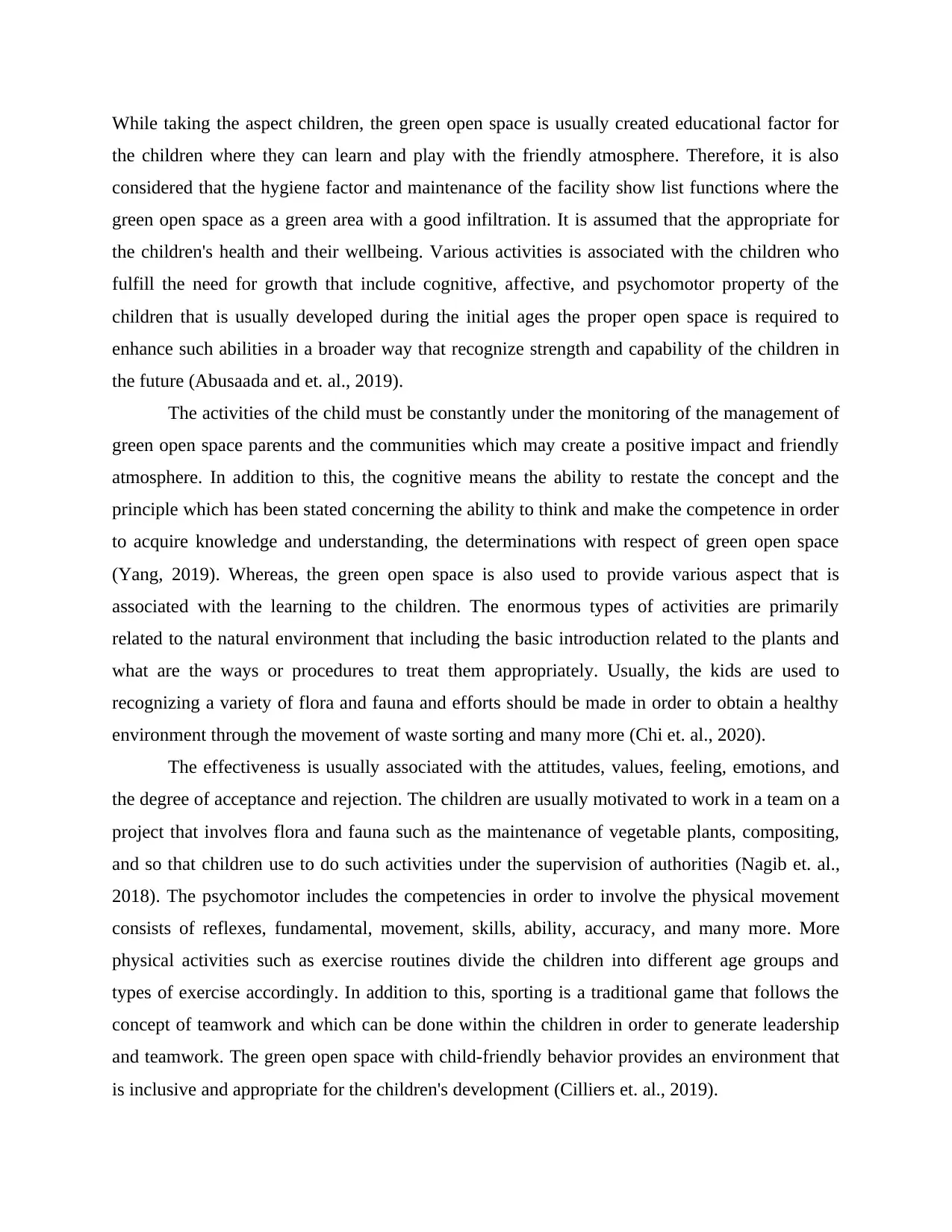
While taking the aspect children, the green open space is usually created educational factor for
the children where they can learn and play with the friendly atmosphere. Therefore, it is also
considered that the hygiene factor and maintenance of the facility show list functions where the
green open space as a green area with a good infiltration. It is assumed that the appropriate for
the children's health and their wellbeing. Various activities is associated with the children who
fulfill the need for growth that include cognitive, affective, and psychomotor property of the
children that is usually developed during the initial ages the proper open space is required to
enhance such abilities in a broader way that recognize strength and capability of the children in
the future (Abusaada and et. al., 2019).
The activities of the child must be constantly under the monitoring of the management of
green open space parents and the communities which may create a positive impact and friendly
atmosphere. In addition to this, the cognitive means the ability to restate the concept and the
principle which has been stated concerning the ability to think and make the competence in order
to acquire knowledge and understanding, the determinations with respect of green open space
(Yang, 2019). Whereas, the green open space is also used to provide various aspect that is
associated with the learning to the children. The enormous types of activities are primarily
related to the natural environment that including the basic introduction related to the plants and
what are the ways or procedures to treat them appropriately. Usually, the kids are used to
recognizing a variety of flora and fauna and efforts should be made in order to obtain a healthy
environment through the movement of waste sorting and many more (Chi et. al., 2020).
The effectiveness is usually associated with the attitudes, values, feeling, emotions, and
the degree of acceptance and rejection. The children are usually motivated to work in a team on a
project that involves flora and fauna such as the maintenance of vegetable plants, compositing,
and so that children use to do such activities under the supervision of authorities (Nagib et. al.,
2018). The psychomotor includes the competencies in order to involve the physical movement
consists of reflexes, fundamental, movement, skills, ability, accuracy, and many more. More
physical activities such as exercise routines divide the children into different age groups and
types of exercise accordingly. In addition to this, sporting is a traditional game that follows the
concept of teamwork and which can be done within the children in order to generate leadership
and teamwork. The green open space with child-friendly behavior provides an environment that
is inclusive and appropriate for the children's development (Cilliers et. al., 2019).
the children where they can learn and play with the friendly atmosphere. Therefore, it is also
considered that the hygiene factor and maintenance of the facility show list functions where the
green open space as a green area with a good infiltration. It is assumed that the appropriate for
the children's health and their wellbeing. Various activities is associated with the children who
fulfill the need for growth that include cognitive, affective, and psychomotor property of the
children that is usually developed during the initial ages the proper open space is required to
enhance such abilities in a broader way that recognize strength and capability of the children in
the future (Abusaada and et. al., 2019).
The activities of the child must be constantly under the monitoring of the management of
green open space parents and the communities which may create a positive impact and friendly
atmosphere. In addition to this, the cognitive means the ability to restate the concept and the
principle which has been stated concerning the ability to think and make the competence in order
to acquire knowledge and understanding, the determinations with respect of green open space
(Yang, 2019). Whereas, the green open space is also used to provide various aspect that is
associated with the learning to the children. The enormous types of activities are primarily
related to the natural environment that including the basic introduction related to the plants and
what are the ways or procedures to treat them appropriately. Usually, the kids are used to
recognizing a variety of flora and fauna and efforts should be made in order to obtain a healthy
environment through the movement of waste sorting and many more (Chi et. al., 2020).
The effectiveness is usually associated with the attitudes, values, feeling, emotions, and
the degree of acceptance and rejection. The children are usually motivated to work in a team on a
project that involves flora and fauna such as the maintenance of vegetable plants, compositing,
and so that children use to do such activities under the supervision of authorities (Nagib et. al.,
2018). The psychomotor includes the competencies in order to involve the physical movement
consists of reflexes, fundamental, movement, skills, ability, accuracy, and many more. More
physical activities such as exercise routines divide the children into different age groups and
types of exercise accordingly. In addition to this, sporting is a traditional game that follows the
concept of teamwork and which can be done within the children in order to generate leadership
and teamwork. The green open space with child-friendly behavior provides an environment that
is inclusive and appropriate for the children's development (Cilliers et. al., 2019).
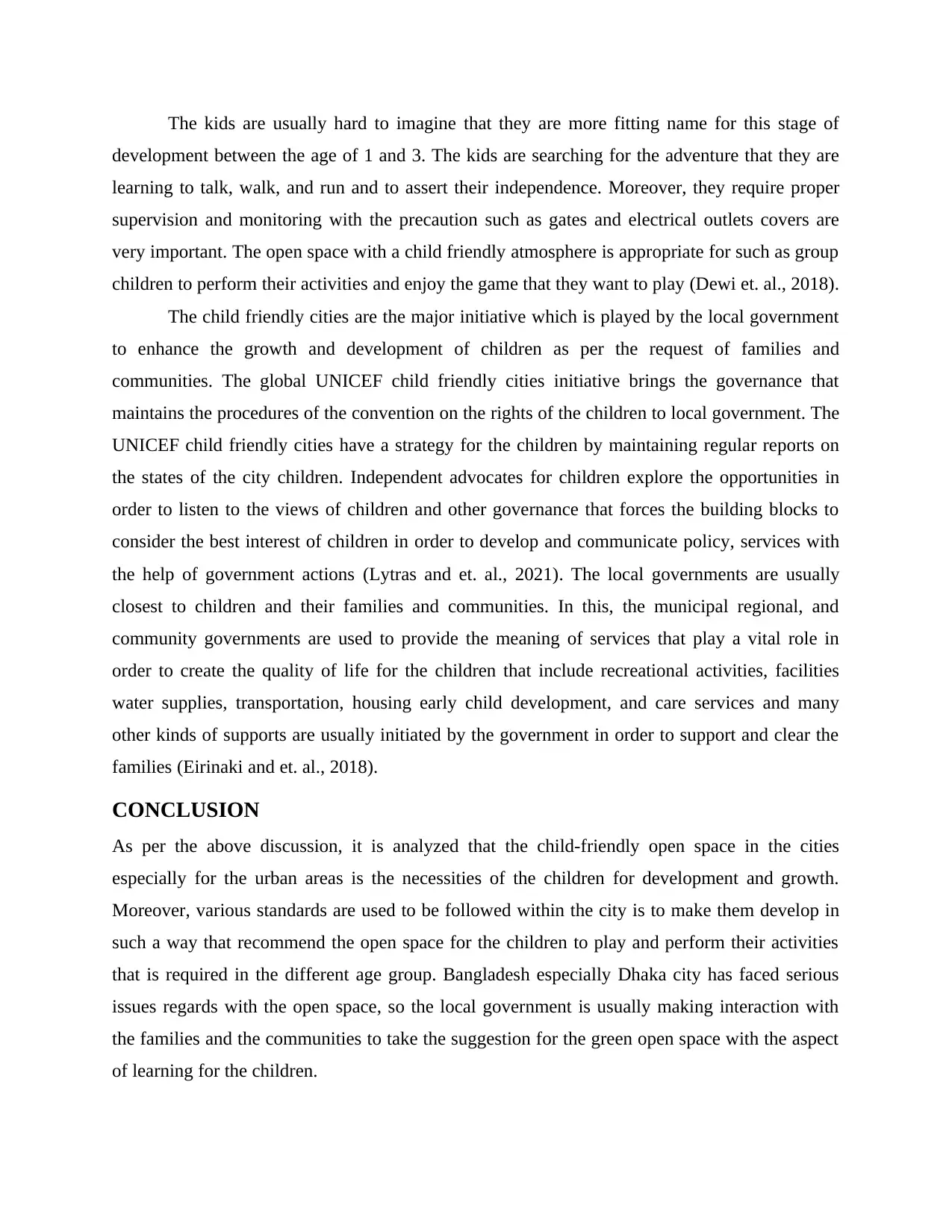
The kids are usually hard to imagine that they are more fitting name for this stage of
development between the age of 1 and 3. The kids are searching for the adventure that they are
learning to talk, walk, and run and to assert their independence. Moreover, they require proper
supervision and monitoring with the precaution such as gates and electrical outlets covers are
very important. The open space with a child friendly atmosphere is appropriate for such as group
children to perform their activities and enjoy the game that they want to play (Dewi et. al., 2018).
The child friendly cities are the major initiative which is played by the local government
to enhance the growth and development of children as per the request of families and
communities. The global UNICEF child friendly cities initiative brings the governance that
maintains the procedures of the convention on the rights of the children to local government. The
UNICEF child friendly cities have a strategy for the children by maintaining regular reports on
the states of the city children. Independent advocates for children explore the opportunities in
order to listen to the views of children and other governance that forces the building blocks to
consider the best interest of children in order to develop and communicate policy, services with
the help of government actions (Lytras and et. al., 2021). The local governments are usually
closest to children and their families and communities. In this, the municipal regional, and
community governments are used to provide the meaning of services that play a vital role in
order to create the quality of life for the children that include recreational activities, facilities
water supplies, transportation, housing early child development, and care services and many
other kinds of supports are usually initiated by the government in order to support and clear the
families (Eirinaki and et. al., 2018).
CONCLUSION
As per the above discussion, it is analyzed that the child-friendly open space in the cities
especially for the urban areas is the necessities of the children for development and growth.
Moreover, various standards are used to be followed within the city is to make them develop in
such a way that recommend the open space for the children to play and perform their activities
that is required in the different age group. Bangladesh especially Dhaka city has faced serious
issues regards with the open space, so the local government is usually making interaction with
the families and the communities to take the suggestion for the green open space with the aspect
of learning for the children.
development between the age of 1 and 3. The kids are searching for the adventure that they are
learning to talk, walk, and run and to assert their independence. Moreover, they require proper
supervision and monitoring with the precaution such as gates and electrical outlets covers are
very important. The open space with a child friendly atmosphere is appropriate for such as group
children to perform their activities and enjoy the game that they want to play (Dewi et. al., 2018).
The child friendly cities are the major initiative which is played by the local government
to enhance the growth and development of children as per the request of families and
communities. The global UNICEF child friendly cities initiative brings the governance that
maintains the procedures of the convention on the rights of the children to local government. The
UNICEF child friendly cities have a strategy for the children by maintaining regular reports on
the states of the city children. Independent advocates for children explore the opportunities in
order to listen to the views of children and other governance that forces the building blocks to
consider the best interest of children in order to develop and communicate policy, services with
the help of government actions (Lytras and et. al., 2021). The local governments are usually
closest to children and their families and communities. In this, the municipal regional, and
community governments are used to provide the meaning of services that play a vital role in
order to create the quality of life for the children that include recreational activities, facilities
water supplies, transportation, housing early child development, and care services and many
other kinds of supports are usually initiated by the government in order to support and clear the
families (Eirinaki and et. al., 2018).
CONCLUSION
As per the above discussion, it is analyzed that the child-friendly open space in the cities
especially for the urban areas is the necessities of the children for development and growth.
Moreover, various standards are used to be followed within the city is to make them develop in
such a way that recommend the open space for the children to play and perform their activities
that is required in the different age group. Bangladesh especially Dhaka city has faced serious
issues regards with the open space, so the local government is usually making interaction with
the families and the communities to take the suggestion for the green open space with the aspect
of learning for the children.
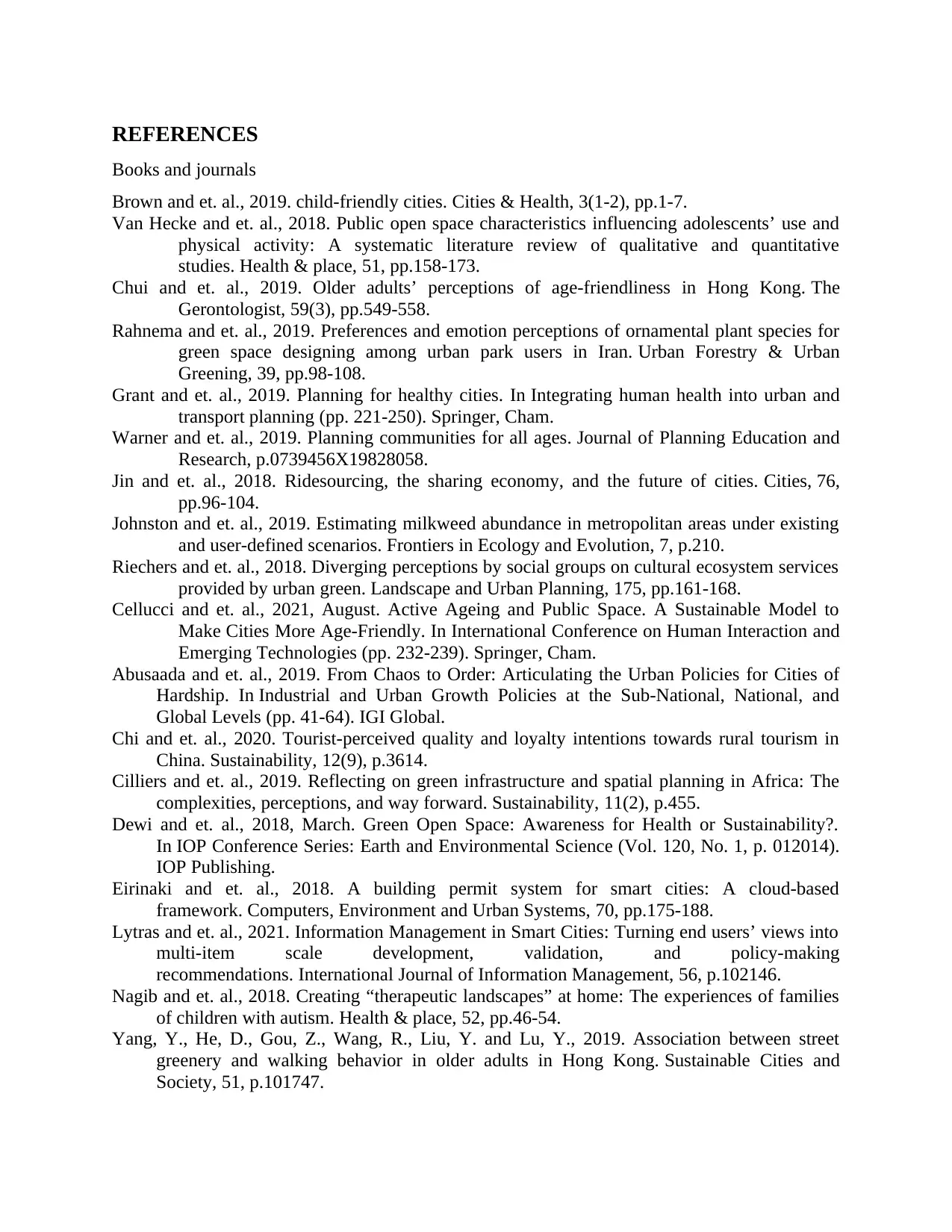
REFERENCES
Books and journals
Brown and et. al., 2019. child-friendly cities. Cities & Health, 3(1-2), pp.1-7.
Van Hecke and et. al., 2018. Public open space characteristics influencing adolescents’ use and
physical activity: A systematic literature review of qualitative and quantitative
studies. Health & place, 51, pp.158-173.
Chui and et. al., 2019. Older adults’ perceptions of age-friendliness in Hong Kong. The
Gerontologist, 59(3), pp.549-558.
Rahnema and et. al., 2019. Preferences and emotion perceptions of ornamental plant species for
green space designing among urban park users in Iran. Urban Forestry & Urban
Greening, 39, pp.98-108.
Grant and et. al., 2019. Planning for healthy cities. In Integrating human health into urban and
transport planning (pp. 221-250). Springer, Cham.
Warner and et. al., 2019. Planning communities for all ages. Journal of Planning Education and
Research, p.0739456X19828058.
Jin and et. al., 2018. Ridesourcing, the sharing economy, and the future of cities. Cities, 76,
pp.96-104.
Johnston and et. al., 2019. Estimating milkweed abundance in metropolitan areas under existing
and user-defined scenarios. Frontiers in Ecology and Evolution, 7, p.210.
Riechers and et. al., 2018. Diverging perceptions by social groups on cultural ecosystem services
provided by urban green. Landscape and Urban Planning, 175, pp.161-168.
Cellucci and et. al., 2021, August. Active Ageing and Public Space. A Sustainable Model to
Make Cities More Age-Friendly. In International Conference on Human Interaction and
Emerging Technologies (pp. 232-239). Springer, Cham.
Abusaada and et. al., 2019. From Chaos to Order: Articulating the Urban Policies for Cities of
Hardship. In Industrial and Urban Growth Policies at the Sub-National, National, and
Global Levels (pp. 41-64). IGI Global.
Chi and et. al., 2020. Tourist-perceived quality and loyalty intentions towards rural tourism in
China. Sustainability, 12(9), p.3614.
Cilliers and et. al., 2019. Reflecting on green infrastructure and spatial planning in Africa: The
complexities, perceptions, and way forward. Sustainability, 11(2), p.455.
Dewi and et. al., 2018, March. Green Open Space: Awareness for Health or Sustainability?.
In IOP Conference Series: Earth and Environmental Science (Vol. 120, No. 1, p. 012014).
IOP Publishing.
Eirinaki and et. al., 2018. A building permit system for smart cities: A cloud-based
framework. Computers, Environment and Urban Systems, 70, pp.175-188.
Lytras and et. al., 2021. Information Management in Smart Cities: Turning end users’ views into
multi-item scale development, validation, and policy-making
recommendations. International Journal of Information Management, 56, p.102146.
Nagib and et. al., 2018. Creating “therapeutic landscapes” at home: The experiences of families
of children with autism. Health & place, 52, pp.46-54.
Yang, Y., He, D., Gou, Z., Wang, R., Liu, Y. and Lu, Y., 2019. Association between street
greenery and walking behavior in older adults in Hong Kong. Sustainable Cities and
Society, 51, p.101747.
Books and journals
Brown and et. al., 2019. child-friendly cities. Cities & Health, 3(1-2), pp.1-7.
Van Hecke and et. al., 2018. Public open space characteristics influencing adolescents’ use and
physical activity: A systematic literature review of qualitative and quantitative
studies. Health & place, 51, pp.158-173.
Chui and et. al., 2019. Older adults’ perceptions of age-friendliness in Hong Kong. The
Gerontologist, 59(3), pp.549-558.
Rahnema and et. al., 2019. Preferences and emotion perceptions of ornamental plant species for
green space designing among urban park users in Iran. Urban Forestry & Urban
Greening, 39, pp.98-108.
Grant and et. al., 2019. Planning for healthy cities. In Integrating human health into urban and
transport planning (pp. 221-250). Springer, Cham.
Warner and et. al., 2019. Planning communities for all ages. Journal of Planning Education and
Research, p.0739456X19828058.
Jin and et. al., 2018. Ridesourcing, the sharing economy, and the future of cities. Cities, 76,
pp.96-104.
Johnston and et. al., 2019. Estimating milkweed abundance in metropolitan areas under existing
and user-defined scenarios. Frontiers in Ecology and Evolution, 7, p.210.
Riechers and et. al., 2018. Diverging perceptions by social groups on cultural ecosystem services
provided by urban green. Landscape and Urban Planning, 175, pp.161-168.
Cellucci and et. al., 2021, August. Active Ageing and Public Space. A Sustainable Model to
Make Cities More Age-Friendly. In International Conference on Human Interaction and
Emerging Technologies (pp. 232-239). Springer, Cham.
Abusaada and et. al., 2019. From Chaos to Order: Articulating the Urban Policies for Cities of
Hardship. In Industrial and Urban Growth Policies at the Sub-National, National, and
Global Levels (pp. 41-64). IGI Global.
Chi and et. al., 2020. Tourist-perceived quality and loyalty intentions towards rural tourism in
China. Sustainability, 12(9), p.3614.
Cilliers and et. al., 2019. Reflecting on green infrastructure and spatial planning in Africa: The
complexities, perceptions, and way forward. Sustainability, 11(2), p.455.
Dewi and et. al., 2018, March. Green Open Space: Awareness for Health or Sustainability?.
In IOP Conference Series: Earth and Environmental Science (Vol. 120, No. 1, p. 012014).
IOP Publishing.
Eirinaki and et. al., 2018. A building permit system for smart cities: A cloud-based
framework. Computers, Environment and Urban Systems, 70, pp.175-188.
Lytras and et. al., 2021. Information Management in Smart Cities: Turning end users’ views into
multi-item scale development, validation, and policy-making
recommendations. International Journal of Information Management, 56, p.102146.
Nagib and et. al., 2018. Creating “therapeutic landscapes” at home: The experiences of families
of children with autism. Health & place, 52, pp.46-54.
Yang, Y., He, D., Gou, Z., Wang, R., Liu, Y. and Lu, Y., 2019. Association between street
greenery and walking behavior in older adults in Hong Kong. Sustainable Cities and
Society, 51, p.101747.
Secure Best Marks with AI Grader
Need help grading? Try our AI Grader for instant feedback on your assignments.

1 out of 11
Related Documents
Your All-in-One AI-Powered Toolkit for Academic Success.
+13062052269
info@desklib.com
Available 24*7 on WhatsApp / Email
![[object Object]](/_next/static/media/star-bottom.7253800d.svg)
Unlock your academic potential
© 2024 | Zucol Services PVT LTD | All rights reserved.




